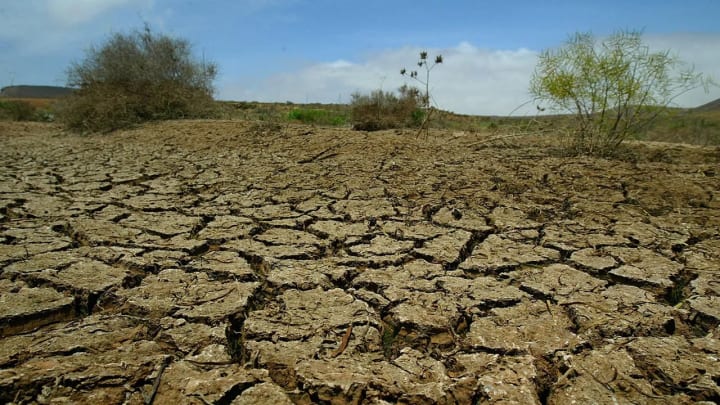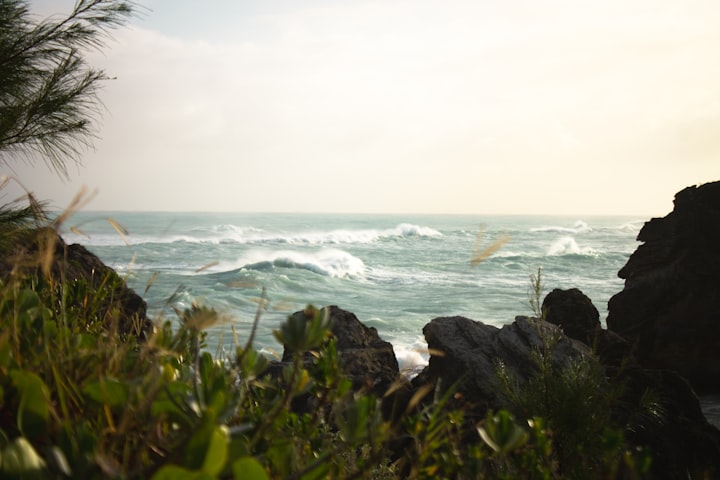The outrageous plan to haul icebergs to Africa
As South Africa faces ever more severe water shortages, some experts are seriously considering a proposal to harvest Antarctic icebergs and haul them to Cape Town. What are the chances it will succeed?

If towing icebergs to hot, water-stressed regions sounds totally crazy to you, then consider this: the volume of water that breaks off Antarctica as icebergs each year is greater than the total global consumption of freshwater. And that stat doesn’t even include Arctic ice. This is pure freshwater, effectively wasted as it melts into the sea and contributes to rising sea levels. Does it sound less crazy now?
This untapped flow of water has enticed scientists and entrepreneurs for over a century.There were 19th-Century schemes to deliver by steam-boat to India, and to supply breweries in Chile. In the 1940s, John Isaacs of the Scripps Oceanographic Institute proposed towing an iceberg to San Diego to quench a Californian drought. In the 1970s, Saudi Prince Mohamed Al-Faisal wanted to tow an Antarctic iceberg across the equator to Saudi Arabia, and funded two international conferences on the subject. The EU received proposals in the 2010s to tow an iceberg from Newfoundland to the Canary Islands.
All these plans have one thing in common, however – none of them ever actually happened.
If you like this:
Yandex: The rise of Russia’s Google
The world’s most prolific writer is an algorithm
How to drink from the enormous lakes in the air
Yet they still keep coming. The latest iceberg-towing schemes to emerge have come from Cape Town and the United Arab Emirates – two regions suffering from extreme and persistent water shortages. In the spring of 2018, Cape Town came ominously near to ‘Day Zero’ – the day the reservoirs dried up and a city of four million people would run out of water. Personal use of water was limited to 50 litres per day. When the rains finally came, Day Zero was averted, but perhaps only for another year. Meanwhile in the UAE, one of the world’s most arid states, the energy minister has declared water consumption a "huge concern" for the country, adding, “we are trying to find alternative solutions”. Could the alternative be icebergs?

The latest iceberg proposals read like a heist movie. Most of the plans since the 1970s have involved the same names who, now in their 70s and 80s, are coming back for ‘one last job’. The potential bounty – a several million-tonne diamond of ice – is just too big for them to resist. But this is no bunch crackpots or chancers. They include some of the biggest names in glaciology: Professor Peter Wadhams, director of the Scott Polar Research Institute, Cambridge, from 1987-92; Dr Olav Orheim, director of the Norwegian Polar Institute from 1993 to 2005; and Georges Mougin, the original French engineer behind Prince Al-Faisal’s scheme.
Peter Wadhams first became aware of Isaac’s 1940s proposal while working at Scripps at the start of his career. “Prince Faisal then cottoned onto this idea, and asked ‘can we tow icebergs to Saudi Arabia?’ Of course, the obvious answer is ‘no’ because you’ve got to get them across the equator and they melt, but nobody told him that because he had a lot of money to put in, and he funded a lot of research.” Two Saudi-funded conferences later – at Ames, Iowa, and the Scott Polar Research Institute, featuring plans by Wadhams, Mougin and Orheim – convinced a lot of people that it could be done. Only, not as far as the Gulf. The tow needed to be done within a reasonably narrow latitude and in relatively cold waters. The Saudi project failed on both counts, and the project was shelved in the early 1980s, says Wadhams, “but we continued to think about it and work on it, without significant funding.”

In 2010, the gang – Wadhams, Mougin and Orheim – reformed. Orheim admits that he hadn’t heard from Mougin for decades. “Normally in science, things done 40 years ago are not really relevant anymore because the science has moved on”, says Orheim. “But in this particular case, there was very little iceberg research done afterwards… We landed on and studied 24 [Antarctic] icebergs [between 1978-79] and the subsequent landings since that time have probably been no more than half of that.”
A geo-textile skirt would wrap around the iceberg and reduce its melt-rate
In 2010, Mougin enlisted a French computer-aided design (CAD) company, Dassault Systèmes, to use the latest satellite tracking and computer modelling to test the idea of a trans-Atlantic tow: a 3D-scan of a real seven-million-tonne iceberg, and the previous year’s weather data and sea currents, produced a computer model of a theoretical tow from Newfoundland to Tenerife, in the Canary Islands. “The model was using one very powerful oil rig towing tug, about 6,000 horsepower, far more powerful than the tugs available in the 1970s and 80s”, says Wadhams. Other technological upgrades in the intervening years included live satellite tracking, and an insulating fabric mesh or “geo-textile skirt” – all 3km of it – designed by Mougin to wrap around the iceberg to reduce the melt-rate. The same material is used on ski slopes in the Alps to stop snow from melting. After fitting the ‘skirt’, the tug would tow the iceberg using a large fishing trawl net.
The model (which included one strong mid-Atlantic storm) showed that the iceberg could be successfully delivered in 141 days, at an average speed of 1.5km per hour (0.8 knots), consuming 4,000 tonnes of shipping fuel. The iceberg would reduce from 7.0 million tonnes to 4.08 million tonnes upon delivery – still a very large amount of water. “It turned out to be a credibly cheap and environmentally sound way of getting water to the Canary Islands”, insists Wadhams. “At the moment [the Canaries] are dependent on desalination plants, which are a complete disaster from the amount of energy they use and the saline water waste product, which then kills off coastal marine life.”

Wadhams and Mougin approached the EU to fund the tow for real. It was seriously considered, claims Wadhams, but no one wanted their name attached should it go wrong. The interest from the international press, and potential for ridicule, would be significant. And 141 days is a long time for something to go wrong.
While the EU said no, the next interested party came from the UAE. Abdulla Alshehi is the founder and managing director of National Advisor Bureau Limited, based in Masdar City – Abu Dhabi’s smart city and ‘cleantech’ hub. Despite a background in fossil fuels as a gas consultant, his passion is the environment. In 2015 he self-published a book called ‘Filling the Empty Quarter: Declaring a Green Jihad On the Desert’, which outlined his plans to convert the Arabian desert into lush, green pasture, by installing a 500km undersea pipeline to the Dasht river, Pakistan. Compared to that, towing icebergs from Antarctica was an easy option.
Alshehi informs me that a feasibility study showed that the project has potential. “Our most likely plan is to tow the iceberg to the eastern coast of the United Arab Emirates, as we cannot bring it to Dubai harbour due to the depth of the strait of Hurmuz,” he tells me. “Our expectation is to tow an iceberg 40 million tonnes in size.” That is more than five times bigger than the Tenerife iceberg, given that so much of it would melt due to the long distance and warm waters. It is privately funded, Alshehi says, but still requires government approval – to achieve that, his team first have to perform a trial run. “We expect that by second quarter of 2019 to start the first pilot run to Australia”, he says.

However, few other experts are optimistic. “I have been on [his] advising committee”, confirms Wadhams, “but I suspect, even with the [melt] protection, that you still can’t really do a trans-equator tow.” The UAE has much the same problems as the original Saudi plan, with sea temperatures in the Gulf of between 24-32 degrees Celsius. Orheim describes Alshehi’s plan as “on the outer limits of what is realistic… You have the major challenge of melt all the way.”
A plan that might yet happen, however, is the Cape Town ‘heist’. This time, Mougin and Orheim have joined a crew led by Captain Nick Sloane, of Cape Town-based marine engineering company Resolve Marine. Sloane is world-renowned in the field of marine salvage, having led the team who re-floated the Italian Costa Concordia wreck in 2014. When BBC Future speaks to him, he is off the coast of the Philippines salvaging a wrecked lift boat – a huge sea-crane the size of a 36-storey building. Towing large unwieldy objects in rough seas is what Sloane does. And he is convinced that he can tow an iceberg to the Cape.
“We have spent two months satellite tracking icebergs [around] our target area”, he tells me. The ‘target’ is penguin-covered Gough Island in the South Atlantic, 2,700 km (1,700 miles) west from Cape Town. There they hope to pick up an 85-100 million-tonne iceberg – twice the size of the UAE mission, and 10 times that of the Tenerife proposal. “Arctic icebergs are a completely different animal, they are unstable and have a lot of saline fractures and faults,” Sloane tells me. “Antarctic icebergs are all tabular, they [are as flat as] a dining room table, they are much more solid and their core temperature is much colder.” The tow to Cape Town, says Sloane – who would captain the mission – would take 80-90 days, at 0.8-1.2 knots, using a supertanker (with over 20,000 horsepower), plus three tugs.
You would only need enough brute force to change the iceberg’s tracks – other than that, the currents would do the delivery job
Central to the plan are the natural currents that converge around Gough Island: the Circumpolar Current, which runs like a ring road of icebergs around the Antarctic, and the Benguela Current, which runs in an arc from Gough Island to the cape and up the west coast of Africa. Sloane describes the challenge as simply “changing train tracks at an intersection”. The tugs would only need enough brute force to change tracks – other than that, the currents would do the delivery job for them. Even the destination point near the Cape, where the iceberg would be pinned into place using oil rig anchors 40 km offshore, remains in a cold current, reducing the melt-rate. The water would be harvested using open cast mining techniques carving into the top of the iceberg, with shuttle tankers carrying the water to the shore.

But the water needs a buyer. When I contact the Cape Town authorities, the response isn’t positive. Councillor Xanthea Limberg, who heads the mayoral committee member for water and waste services, tells me bluntly: “This proposal has not been considered suitable for Cape Town… Such a project is both complex and risky with an anticipated very high-water cost.” According to costings done by the City, the melt water is likely to cost approximately R29 per 1000 litres (roughly $2 or £1.50 per 1000 litres), excluding the cost of infrastructure required to get the melt water onshore, which “is likely to be substantial”, compared to R5,20 per 1000 litres ($0.36/£0.27) from surface water schemes: “The City of Cape Town is therefore rather focussing on increasing groundwater abstraction, desalination, and capacity to treat and reuse wastewater,” says Limberg.
Glacial progress
However, Sloane and his team are not deterred. While the city runs the water infrastructure, it’s the national government that owns it. Sloane confirms that the city’s costings are about right. Surface water schemes are indeed a lot cheaper. However, iceberg water would not compete with groundwater but with costly desalination (or ‘desal’) – which has received huge sums of investment from the city.. “Desalination cost can be up above R50 ($3.35/£2.55) per 1000 litres”, says Sloane, “and long-term ‘desal’ [including the cost to build new plants] starts above R250 ($16.75/£12.75)… basically there is nothing cheaper than water from a dam. We’re not trying to replace that. We’re just trying to supplement it.” Sloane believes an undersea pipe could directly feed pure meltwater into the reservoirs, topping them back up.
In a final pitch to make the plan palatable to politicians, Sloane is now offering the water risk-free. Investors, Swiss-based Water Vision plus “two South African banks and one insurance company”, are offering to fund the tow in its entirety, meaning that if it melts, fractures, or strays off course, the state authorities wouldn’t have to pay a penny. The cost would be a delivery charge upon arrival. It could be the right offer – and the right team, in the right location – that finally makes iceberg towing a reality.
In September, Sloane, Orheim, Mougin and others were invited to make their pitch to the national government’s advisory body Water Research Commission (WRC). Sloane tells me afterwards that it went well. The WRC’s Dr Shafick Adams agreed that his group needed to be “more adventurous in our thinking”, and was keen to do this, but still wanted more detail on “the scientific, environmental and economic feasibility”. Sloane tells me the weather window for a 2018 tug has now closed, meaning it would be 2019 at the earliest.
But there is a final twist in the tale. There are companies and vessels in the world that already, regularly, tow icebergs. Off the coast of Newfoundland expensive oil platforms need to be protected from the regular flow of icebergs – this is the sea where the Titanic was sunk. Organisations such as C-Core and Atlantic Towing are hired by oil companies for iceberg protection. And, in brief, they think the plans of Mougin and others are unrealistic, to say the least.
From an engineering perspective… it would probably have a [prohibitive] greenhouse gas footprint – Deidre Greene-Lono
Deirdre Greene-Lono, C-Core’s corporate communications manager tells me, politely but dismissively: “C-Core is frequently asked about the possibility of towing icebergs from their natural ‘habitat’ to parts of the world where water scarcity is an issue, especially when Mougin’s concept floats to the surface… It would be lovely if they worked. But from an engineering perspective… it would probably have a [prohibitive] greenhouse gas footprint.”

The longest tow she has heard of lasted 24 hours and was a massive logistical exercise. Atlantic Towing’s offshore director, Sheldon Lace, tells me their record is a three-to-four day tow. He says that to haul a large, stable iceberg would require at least 40–50 metric tonnes of fuel per day, per vessel. A single tug towing for 100 days would therefore burn through 5,000 metric tonnes of fuel. That’s enough fuel to drive an average car for 44,000,000 miles – or 1,767 times the circumference of the Earth.
At Memorial University of Newfoundland, Steve Bruneau, associate professor at the faculty of engineering and applied science, is even more dismissive. “I strongly discourage wasting money on the hopeless plan to tow icebergs to desert nations”, he says. “Ignoring all the technical, environmental and thermodynamic problems that would kill the project – the energy consumption … who would pay for it? I sincerely hope that wealth and valuable energy resources are not wasted on this.”
However, both Atlantic Towing and C-Core agree that tabular Antarctic icebergs are easier to tow to than their warmer, less stable Arctic cousins. And there is arguably no-one in the world with more direct experience of icebergs from both poles than Olav Orheim. His only real contender to that crown is Peter Wadhams. “Bringing an iceberg to south-west Africa is not far to tow,” insists Wadhams. “The cold current that washes near to South Africa is a branch of the polar current, so you really just have to nudge the iceberg, you don’t have a lot of melt problems.”
We should also recognise the sheer scale of the resource available, were these plans to succeed. Orheim tells me that “more icebergs come out of Antarctica than the total global consumption of freshwater.” Every year that’s around 140,000 icebergs, or 2,000 billion tons of ice. “There is a never-ending supply. These all melt in the sea. So, all we would be doing is bringing one or two a bit further north.”
Underneath Nick Sloane’s email signature is a quote from Nelson Mandela: "Everything appears to be impossible, and then it is done.” I ask if that was his inspiration for the iceberg project. “No, that’s the theme that we took for the Costa Concordia [salvage mission]”, he says. “We had that up on every door, every vessel… Because a lot of people even on the team were sceptical. But you say, well, if we don’t start it will never happen. So, let’s just start.”
About the Creator
Fortis Rakow
One cannot eat one's cake and have it.






Comments
There are no comments for this story
Be the first to respond and start the conversation.